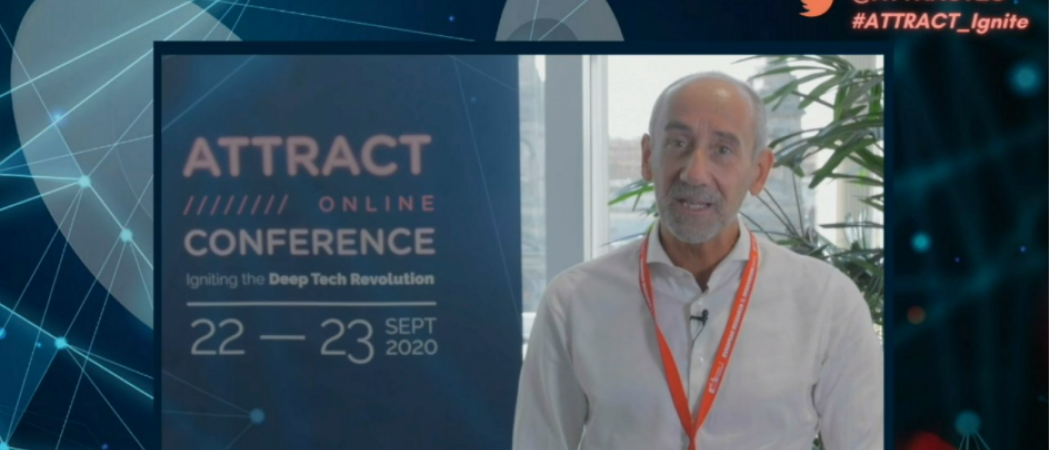170 technologies show how serendipity can be systematised in scientific breakthroughs by applying four mechanisms

Jean-Eric Paquet speaking to the ATTACT conference with a recorded video
Serendipity in the realm of science and technology is an unexpected process in which a scientific discovery or a technological advancement seems to occur by pure chance. But a new study by CERN, Esade Business School, and the Technical University of Denmark shows that there is much more than chance to serendipity. Conditions can be created by forming innovation ecosystems, where serendipity is somehow systematised – leading to streamlined scientific breakthroughs that ignite deep tech innovation in Europe. The findings, based on a large dataset from 170 ATTRACT technologies, were presented at the ATTRACT Conference: Igniting the Deep Tech Revolution, held on 22 September 2020.
The study examines the ATTRACT project, a €20m-funded initiative within the Horizon 2020 Framework Programme that aims to systematise the discovery and development of breakthrough applications for detection and imaging technologies rooted in the instrumentation that pushes the frontiers of fundamental research.
“The large dataset from the 170 ATTRACT technologies allows us to view serendipity in an unprecedented manner and identify how big science research can be used in unexplored ways for commercial applications,” said Jonathan Wareham, professor of Information Systems at Esade Business School and co-author of the report Systematising serendipity for big science infrastructures: the ATTRACT project.
Based on the experience of how 170 breakthrough technologies were used to develop new scientific applications, the report reveals the main four mechanisms that can trigger serendipity to ignite deep tech innovation in Europe and beyond:
- The first mechanism to trigger serendipity (used by 41% of the ATTRACT projects) is combining technologies from different research domains to produce new applications, such as using a photonic system for liquid biopsy or merging gas-sensing and high-pressure technology to create new gas sensors. Under this category, technologies from adjacent or distant domains are combined with varying degrees of integration.
- The second most used mechanism to trigger serendipity is improving technologies from previous research to make them more effective (31% of the projects). This mechanism involves re-examining previous research so that new features can surface that have not been previously identified or explored.
- The third mechanism to trigger serendipity (used by 27% of the projects) is applying existing technologies from one domain to a new research field or application area. This category coincides best with the previous notions of serendipity – finding new uses for existing things. New uses potentially emerge by exposing a technology to a field where it has not been previously used.
- The fourth mechanism to systematically activate serendipity (accounting for 14% of projects) involves the application of machine learning or artificial intelligence to augment or find new uses for existing technologies.
“It is a widely accepted wisdom that increasing the collisions between different innovation actors promotes the chances of serendipity. With its novel constellation of actors, resources, design, and governance, ATTRACT should be seen as an experiment in innovation policy,” said Pablo Tello, one of the co-authors of the report and section head of the Development of EU projects and initiatives at CERN.
Igniting the deep tech revolution in Europe
The ATTRACT Conference brought together researchers, investors, entrepreneurs, and European innovation policymakers to explore how breakthrough technologies will change the future and which model of innovation ecosystem Europe needs for scaling up promising ventures for global markets. “The ATTRACT project has been genuinely ground-breaking. It is the first time that we have connected science and innovation so openly in Europe,” said Director-General of DG Research and Innovation at the European Commission, Jean-Eric Paquet, at the ATTRACT Conference.
“We need to take more risks if we want to give life to potentially impactful ideas,” said Jean-David Malo, Director of the European Innovation Council (EIC) Task Force. He added that the EIC will soon be announcing a new major investment decision to fund promising technologies and accelerate the development of deep tech innovation.
The ATTRACT conference was designed to help ignite a deep tech revolution with insights from the pioneering ATTRACT initiative. Lessons from the ATTRACT project will help better focus future innovation initiatives and prepare the next generation for the deep tech revolution.
For further information: The ATTRACT model of deep tech innovation is featured in a dedicated online workshop on 24 September 2020 (3:15 CEST - 4 pm CEST) in the European Innovation Council Hub of the European Research and Innovation Days.
This press release was first published by ATTRACT on 22 September 2020.





 A unique international forum for public research organisations and companies to connect their external engagement with strategic interests around their R&D system.
A unique international forum for public research organisations and companies to connect their external engagement with strategic interests around their R&D system.